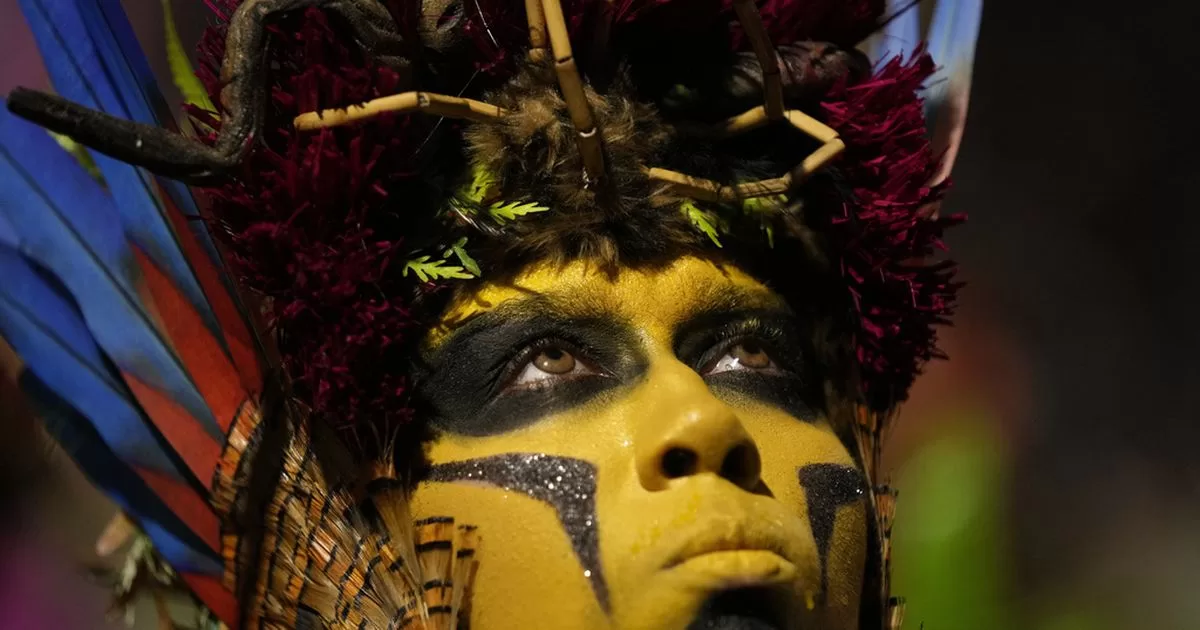It was all part of the Salgueiro samba school’s tribute to the Yanomami, Brazil’s largest indigenous group. The large floats, costumes and songs alluded to the group’s ancient culture and traditions.
“My Salgueiro is the arrow for the people of the forest,” chanted the participants in the parade as they toured the Sambódromo and transmitted their message to more than 70,000 attendees at the venue and millions of people who followed it on television. “The opportunity we have left is an indigenous Brazil.”
President Luiz Inácio Lula da Silva is under pressure to make good on his promises to eradicate illegal mining, especially after a recent setback in those efforts. These days mark one year since Lula declared a public health emergency for the Yanomami in the Amazon, who suffer from malnutrition and diseases such as malaria as a result of illegal mining.
Illegal mining is making a comeback
“Ours is a cry for help from Brazil and the world in general,” said Davi Kopenawa, a Yanomami leader and shaman who advised the samba school on how to stay faithful to its people, and who marched with Salgueiro. “My hope is that the world, hearing our call, will pressure the Brazilian government to expel all the miners, destroyers of our mother Earth, who are dirtying the water and killing the fish.”
Kopenawa paraded with bracelets and a feather headdress, as well as a beaded necklace with the image of a jaguar. He was accompanied by 13 other Yanomami who crossed the country by plane to participate in the Salgueiro show. One of the first floats simulated a severed tree trunk, and an artist portrayed a Yanomami mother trying to protect her child as the invaders approached. Other floats featured huge sculptures of Yanomami people.
Through his homage to Yanomami history and culture, Salgueiro wanted to draw attention to the devastating effects of illegal mining within Yanomami territory, including widespread river pollution, famine, and disease.
Some 30,000 Yanomami live in Brazil’s largest indigenous territory, covering more than 9 million hectares (22 million acres) in the northern part of the Amazon forest, along the border with Venezuela.
Three weeks after assuming the presidency, Lula declared a public health emergency and sent in the armed forces, doctors, nurses and food. Still, 300 Yanomami died from various causes in 2023, according to the Ministry of Health.
But after the initial success of the operation, prosecutors, security forces and employees of federal environmental agencies say that the illegal miners are returning.
“There has been a significant reduction, but mining has not ended. We believe that the miners are exploiting as much as possible, because they calculate that at some point they will have to leave,” Jair Schmitt, head of environmental protection at the Brazilian environmental agency Ibama, told The Associated Press.
Schmitt said miners have adapted to evade law enforcement and satellite detection by working at night, setting up camps under tree cover and working in old mine shafts instead of clearing forests to open new ones.
The authorities have also detected that miners are beginning to work in a much more artisanal and small-scale way, said Humberto Freire, director of the newly created Amazon and environmental division of the federal police. Government agencies need to take stronger action, he said.
“For example, we need the air force to effectively control the airspace over Yanomami lands. We need the navy to control the flow of people in the rivers. We also need the army to do quality work,” Freire explained. “The federal police can do more, the armed forces can do more, as well as Ibama and Funai (the indigenous affairs agency).”
In one part of the parade there were dancers dressed in dark green army uniforms. Behind them advanced a float with two large military helmets with skulls, an openly critical element.
The Brazilian Army and its role in the conflict
Lula has said the armed forces will play a key role in the fight by providing logistical support and security to federal officials and agents on the ground, who have expressed growing fear for their lives.
But the army’s responsibility is not to engage in direct combat, said political scientist João Roberto Martins Filho. Still, the big question is why the army, which has three permanent bases in Yanomami territory, did not sound the alarm during the mandate of Lula’s predecessor, Jair Bolsonaro.
“There was almost a massacre of an unprotected population. “Why did the army let this happen instead of reporting it to the federal government or contacting the press?” Martins Filho, a professor at the Federal University of Sao Carlos, asked AP. “In a way, they were complicit.”
In a written response to the AP, the military said that illegal mining and the health crisis within Yanomami territory “are complex issues involving the legal jurisdiction of various government agencies” and that the military “is always prepared to fulfill its strategic missions. That includes providing support to federal agencies through logistics, communication and intelligence activities, such as those carried out in Yanomami territory, the statement added.
Illegal planes are crucial for transporting prospectors and equipment to distant reserves, as a 2022 Associated Press investigation showed in Roraima state, where most of the mining affecting the Yanomami occurs. Without unauthorized aircraft, experts and officials have said illegal mining would collapse.
Following a presidential decree in January 2023 that ordered the air force to close the airspace over Yanomami territory, the situation on the ground improved significantly, authorities and indigenous people told the AP.
In a written response to the AP, the Brazilian air force said it has been patrolling the so-called Defense Identification Air Zone over Yanomami territory. According to that rule, an aircraft could be shot down if it does not comply with orders to change route. The force claims the measure has reduced illegal flights by 90%.
“It is very efficient. We found landing strips, but no planes,” said André Luiz Porreca Ferreira Cunha, a federal prosecutor who oversees cases associated with illegal mining in the western Amazon.
However, some people on the ground suggest that the military is no longer involved enough in operations and illegal miners are beginning to return as a result.
In a joint statement last month, associations representing federal workers on environmental and indigenous issues accused the military of “failing to fulfill its mission to support and facilitate the work of other agencies” against illegal mining. The association stated that the army denied the use of aircraft to transport personnel and equipment, has not collaborated in the destruction of mining machinery and landing strips, and instead closed support points for refueling the environmental agency’s aircraft.
Prosecutor Ferreira Cunha says violent attacks on Ibama and federal police agents are becoming more frequent, with some cases of attempted murder. Government health teams have also been attacked and are unable — or unwilling — to reach some communities, said Júnior Hekurari, a member of the group and president of Condisi-Y, the local health council.
“Some are heavily armed, the health teams are afraid,” he said.
“This state of emergency cannot solve the problem. We need something permanent, for all communities,” Hekurari added. “If (government authorities) don’t stay, the miners will return tomorrow.”
Source: With information from AP





